Abstract
Dehydroepiandrosterone (DHEA) and certain structural analogues block the differentiation of 3T3-L1 mouse embryo fibroblasts to adipocytes. These steroids also are potent uncompetitive inhibitors of mammalian glucose-6-phosphate dehydrogenases (G6PDs). We provide direct evidence that treatment of the 3T3-L1 cells with DHEA and its analogues results in intracellular inhibition of G6PD, which is associated with the block of differentiation: (i) Levels of 6-phosphogluconate and other products of the pentose phosphate pathway are decreased; (ii) the magnitude of these decreases depends on the potency of steroids as inhibitors of G6PD and on concentration and duration of exposure, and it is accompanied by a proportionate block of differentiation; (iii) in cells exposed to 16 alpha-bromoepiandrosterone (a more potent inhibitor of G6PD than DHEA) at concentrations that block differentiation, introduction of exogenous 6-phosphogluconate in liposomes raises the levels of 6-phosphogluconate and other products of the pentose phosphate pathway and partially relieves the steroid block of cell growth and differentiation.
Full text
PDF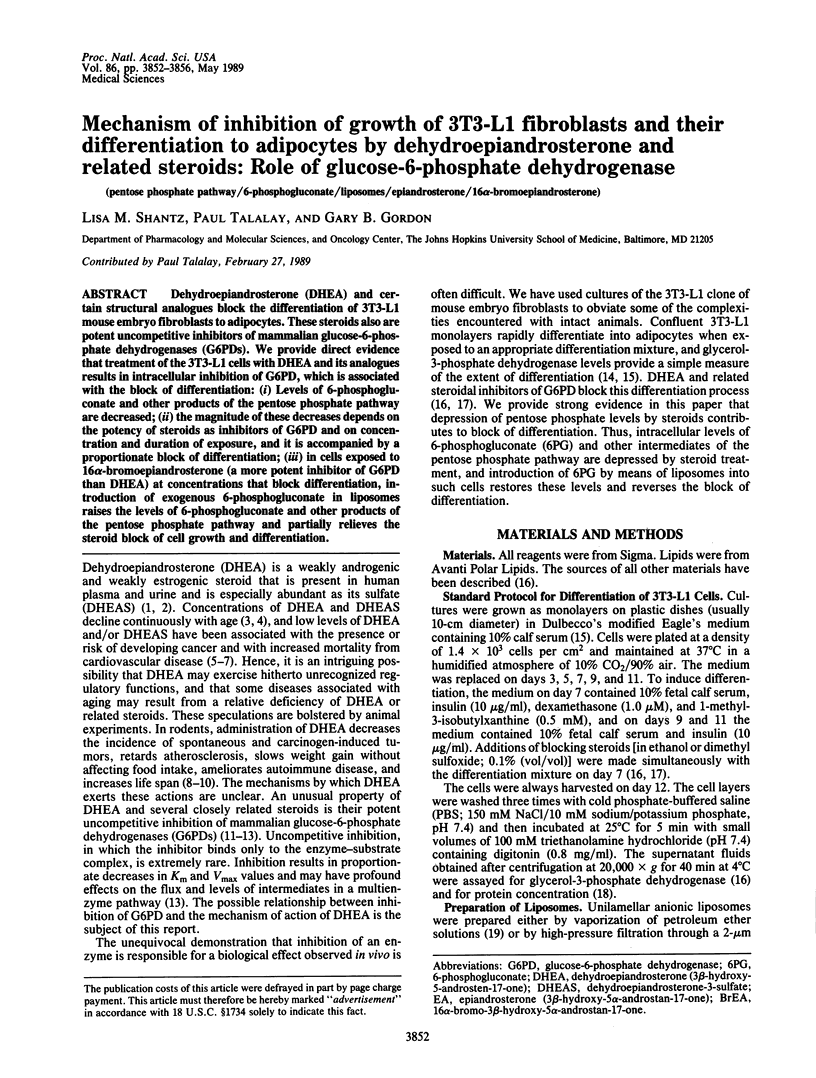
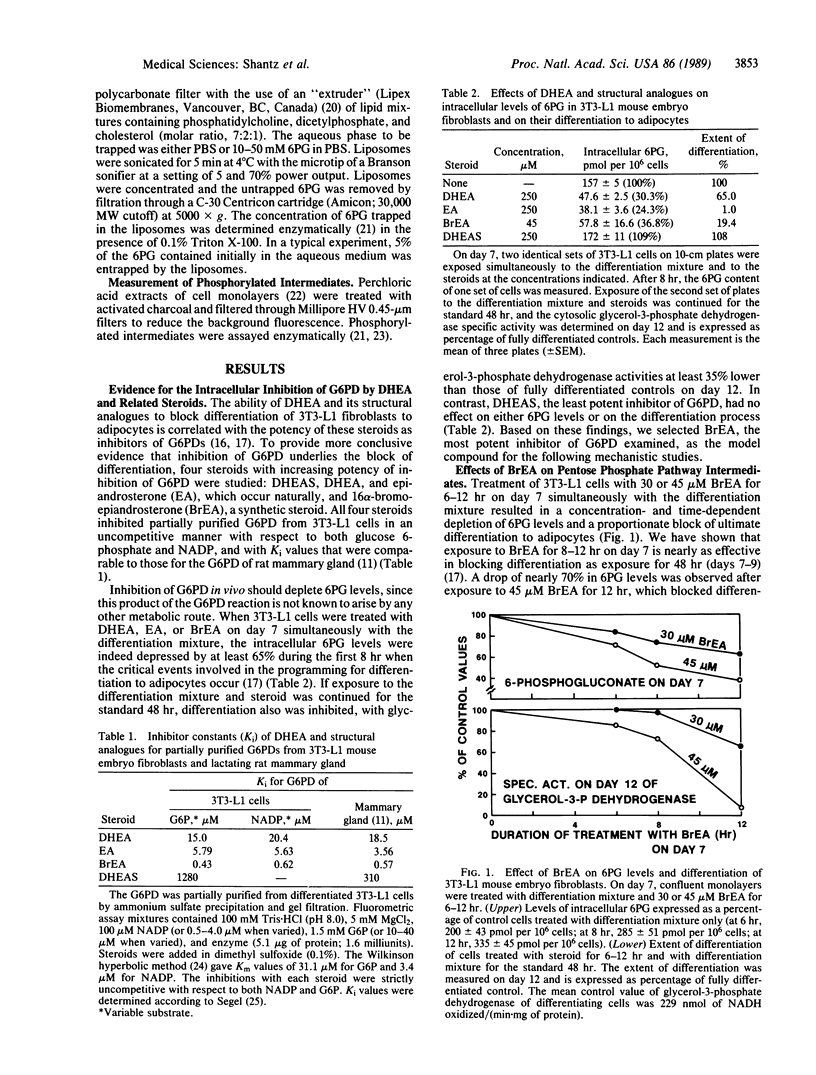
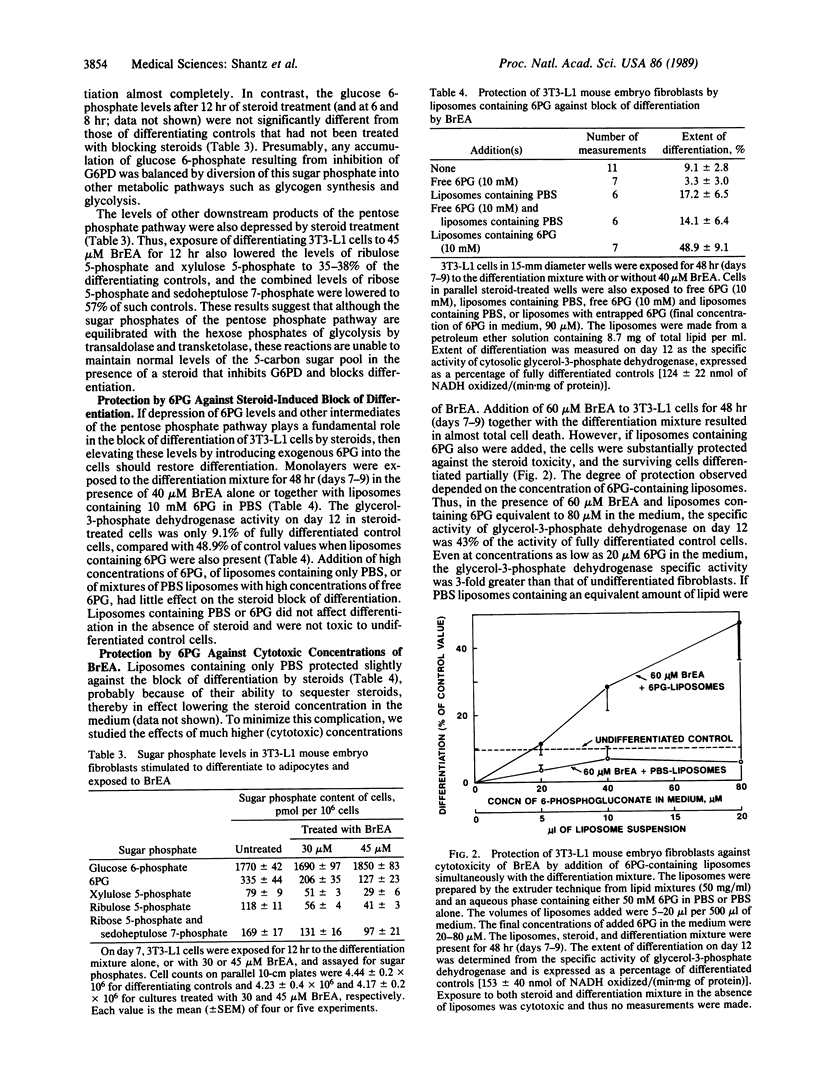
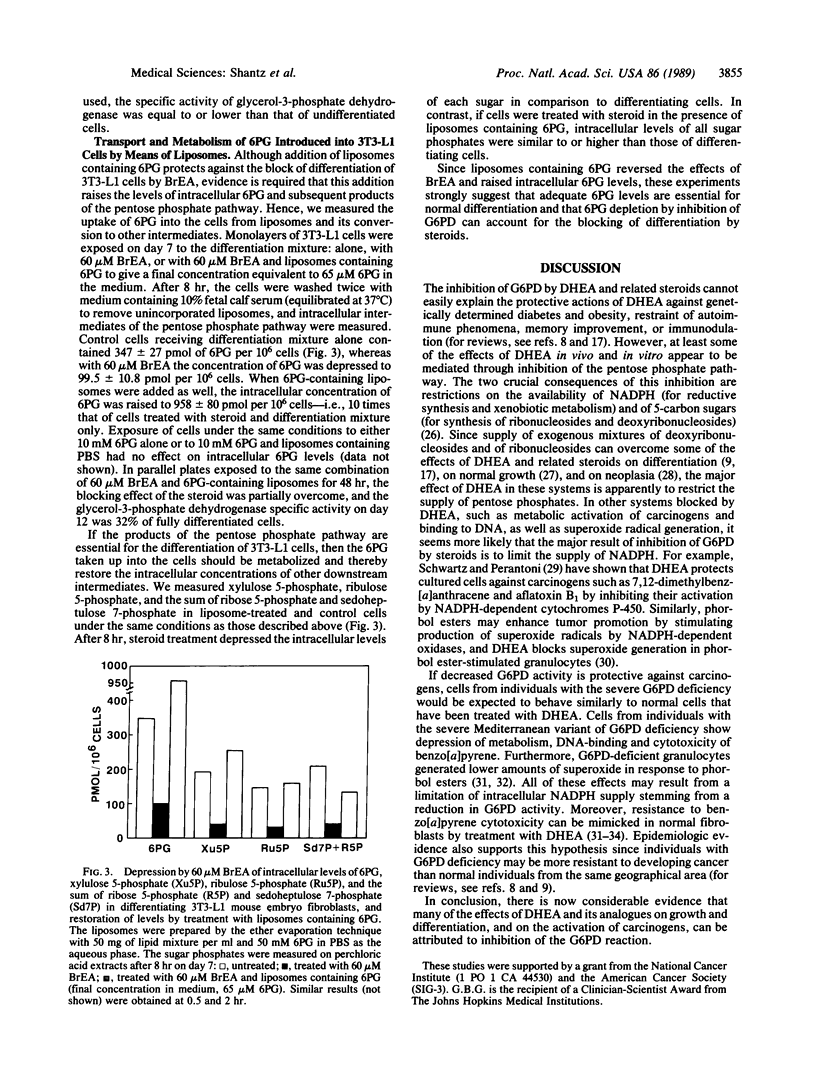
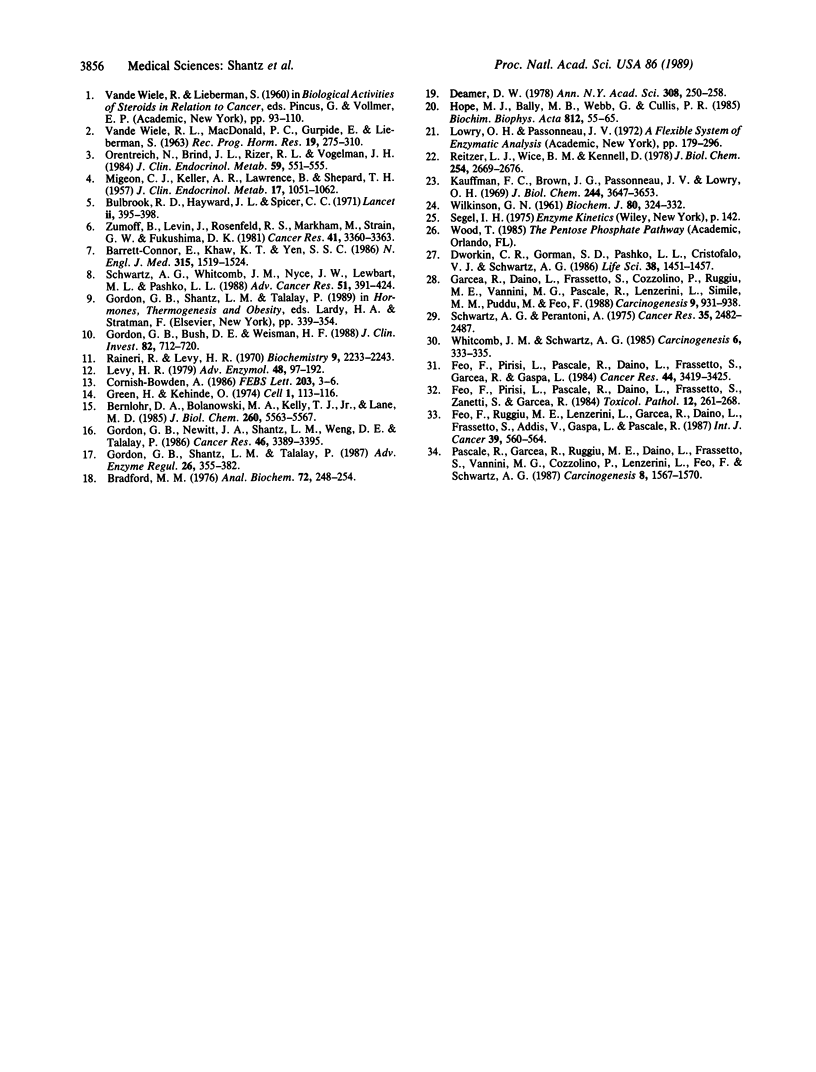
Images in this article
Selected References
These references are in PubMed. This may not be the complete list of references from this article.
- Barrett-Connor E., Khaw K. T., Yen S. S. A prospective study of dehydroepiandrosterone sulfate, mortality, and cardiovascular disease. N Engl J Med. 1986 Dec 11;315(24):1519–1524. doi: 10.1056/NEJM198612113152405. [DOI] [PubMed] [Google Scholar]
- Bernlohr D. A., Bolanowski M. A., Kelly T. J., Jr, Lane M. D. Evidence for an increase in transcription of specific mRNAs during differentiation of 3T3-L1 preadipocytes. J Biol Chem. 1985 May 10;260(9):5563–5567. [PubMed] [Google Scholar]
- Bradford M. M. A rapid and sensitive method for the quantitation of microgram quantities of protein utilizing the principle of protein-dye binding. Anal Biochem. 1976 May 7;72:248–254. doi: 10.1006/abio.1976.9999. [DOI] [PubMed] [Google Scholar]
- Bulbrook R. D., Hayward J. L., Spicer C. C. Relation between urinary androgen and corticoid excretion and subsequent breast cancer. Lancet. 1971 Aug 21;2(7721):395–398. doi: 10.1016/s0140-6736(71)90113-9. [DOI] [PubMed] [Google Scholar]
- Cornish-Bowden A. Why is uncompetitive inhibition so rare? A possible explanation, with implications for the design of drugs and pesticides. FEBS Lett. 1986 Jul 14;203(1):3–6. doi: 10.1016/0014-5793(86)81424-7. [DOI] [PubMed] [Google Scholar]
- Deamer D. W. Preparation and properties of ether-injection liposomes. Ann N Y Acad Sci. 1978;308:250–258. doi: 10.1111/j.1749-6632.1978.tb22027.x. [DOI] [PubMed] [Google Scholar]
- Dworkin C. R., Gorman S. D., Pashko L. L., Cristofalo V. J., Schwartz A. G. Inhibition of growth of HeLa and WI-38 cells by dehydroepiandrosterone and its reversal by ribo- and deoxyribonucleosides. Life Sci. 1986 Apr 21;38(16):1451–1457. doi: 10.1016/0024-3205(86)90557-6. [DOI] [PubMed] [Google Scholar]
- Feo F., Pirisi L., Pascale R., Daino L., Frassetto S., Garcea R., Gaspa L. Modulatory effect of glucose-6-phosphate dehydrogenase deficiency on benzo(a)pyrene toxicity and transforming activity for in vitro-cultured human skin fibroblasts. Cancer Res. 1984 Aug;44(8):3419–3425. [PubMed] [Google Scholar]
- Feo F., Pirisi L., Pascale R., Daino L., Frassetto S., Zanetti S., Garcea R. Modulatory mechanisms of chemical carcinogenesis: the role of the NADPH pool in the benzo(a)pyrene activation. Toxicol Pathol. 1984;12(3):261–268. doi: 10.1177/019262338401200309. [DOI] [PubMed] [Google Scholar]
- Feo F., Ruggiu M. E., Lenzerini L., Garcea R., Daino L., Frassetto S., Addis V., Gaspa L., Pascale R. Benzo(a)pyrene metabolism by lymphocytes from normal individuals and individuals carrying the Mediterranean variant of glucose-6-phosphate dehydrogenase. Int J Cancer. 1987 May 15;39(5):560–564. doi: 10.1002/ijc.2910390504. [DOI] [PubMed] [Google Scholar]
- Garcea R., Daino L., Frassetto S., Cozzolino P., Ruggiu M. E., Vannini M. G., Pascale R., Lenzerini L., Simile M. M., Puddu M. Reversal by ribo- and deoxyribonucleosides of dehydroepiandrosterone-induced inhibition of enzyme altered foci in the liver of rats subjected to the initiation--selection process of experimental carcinogenesis. Carcinogenesis. 1988 Jun;9(6):931–938. doi: 10.1093/carcin/9.6.931. [DOI] [PubMed] [Google Scholar]
- Gordon G. B., Bush D. E., Weisman H. F. Reduction of atherosclerosis by administration of dehydroepiandrosterone. A study in the hypercholesterolemic New Zealand white rabbit with aortic intimal injury. J Clin Invest. 1988 Aug;82(2):712–720. doi: 10.1172/JCI113652. [DOI] [PMC free article] [PubMed] [Google Scholar]
- Gordon G. B., Newitt J. A., Shantz L. M., Weng D. E., Talalay P. Inhibition of the conversion of 3T3 fibroblast clones to adipocytes by dehydroepiandrosterone and related anticarcinogenic steroids. Cancer Res. 1986 Jul;46(7):3389–3395. [PubMed] [Google Scholar]
- Gordon G. B., Shantz L. M., Talalay P. Modulation of growth, differentiation and carcinogenesis by dehydroepiandrosterone. Adv Enzyme Regul. 1987;26:355–382. doi: 10.1016/0065-2571(87)90023-9. [DOI] [PubMed] [Google Scholar]
- Kauffman F. C., Brown J. G., Passonneau J. V., Lowry O. H. Effects of changes in brain metabolism on levels of pentose phosphate pathway intermediates. J Biol Chem. 1969 Jul 10;244(13):3647–3653. [PubMed] [Google Scholar]
- Levy H. R. Glucose-6-phosphate dehydrogenases. Adv Enzymol Relat Areas Mol Biol. 1979;48:97–192. doi: 10.1002/9780470122938.ch3. [DOI] [PubMed] [Google Scholar]
- MIGEON C. J., KELLER A. R., LAWRENCE B., SHEPARD T. H., 2nd Dehydroepiandrosterone and androsterone levels in human plasma: effect of age and sex; day-to-day and diurnal variations. J Clin Endocrinol Metab. 1957 Sep;17(9):1051–1062. doi: 10.1210/jcem-17-9-1051. [DOI] [PubMed] [Google Scholar]
- Orentreich N., Brind J. L., Rizer R. L., Vogelman J. H. Age changes and sex differences in serum dehydroepiandrosterone sulfate concentrations throughout adulthood. J Clin Endocrinol Metab. 1984 Sep;59(3):551–555. doi: 10.1210/jcem-59-3-551. [DOI] [PubMed] [Google Scholar]
- Pascale R., Garcea R., Ruggiu M. E., Daino L., Frassetto S., Vannini M. G., Cozzolino P., Lenzerini L., Feo F., Schwartz A. G. Decreased stimulation by 12-O-tetradecanoylphorbol-13-acetate of superoxide radical production by polymorphonuclear leukocytes carrying the Mediterranean variant of glucose-6-phosphate dehydrogenase. Carcinogenesis. 1987 Oct;8(10):1567–1570. doi: 10.1093/carcin/8.10.1567. [DOI] [PubMed] [Google Scholar]
- Raineri R., Levy H. R. On the specificity of steroid interaction with mammary glucose 6-phosphate dehydrogenase. Biochemistry. 1970 May 26;9(11):2233–2243. doi: 10.1021/bi00813a003. [DOI] [PubMed] [Google Scholar]
- Reitzer L. J., Wice B. M., Kennell D. Evidence that glutamine, not sugar, is the major energy source for cultured HeLa cells. J Biol Chem. 1979 Apr 25;254(8):2669–2676. [PubMed] [Google Scholar]
- Schwartz A. G., Perantoni A. Protective effect of dehydroepiandrosterone against aflatoxin B1-and 7,12-dimethylbenz(a)anthracene-induced cytotoxicity and transformation in cultured cells. Cancer Res. 1975 Sep;35(9):2482–2487. [PubMed] [Google Scholar]
- Schwartz A. G., Whitcomb J. M., Nyce J. W., Lewbart M. L., Pashko L. L. Dehydroepiandrosterone and structural analogs: a new class of cancer chemopreventive agents. Adv Cancer Res. 1988;51:391–424. doi: 10.1016/s0065-230x(08)60227-4. [DOI] [PubMed] [Google Scholar]
- VANDEWIELE R. L., MACDONALD P. C., GURPIDE E., LIEBERMAN S. STUDIES ON THE SECRETION AND INTERCONVERSION OF THE ANDROGENS. Recent Prog Horm Res. 1963;19:275–310. [PubMed] [Google Scholar]
- WILKINSON G. N. Statistical estimations in enzyme kinetics. Biochem J. 1961 Aug;80:324–332. doi: 10.1042/bj0800324. [DOI] [PMC free article] [PubMed] [Google Scholar]
- Whitcomb J. M., Schwartz A. G. Dehydroepiandrosterone and 16 alpha-Br-epiandrosterone inhibit 12-O-tetradecanoylphorbol-13-acetate stimulation of superoxide radical production by human polymorphonuclear leukocytes. Carcinogenesis. 1985 Mar;6(3):333–335. doi: 10.1093/carcin/6.3.333. [DOI] [PubMed] [Google Scholar]
- Zumoff B., Levin J., Rosenfeld R. S., Markham M., Strain G. W., Fukushima D. K. Abnormal 24-hr mean plasma concentrations of dehydroisoandrosterone and dehydroisoandrosterone sulfate in women with primary operable breast cancer. Cancer Res. 1981 Sep;41(9 Pt 1):3360–3363. [PubMed] [Google Scholar]



